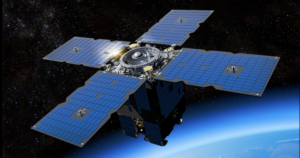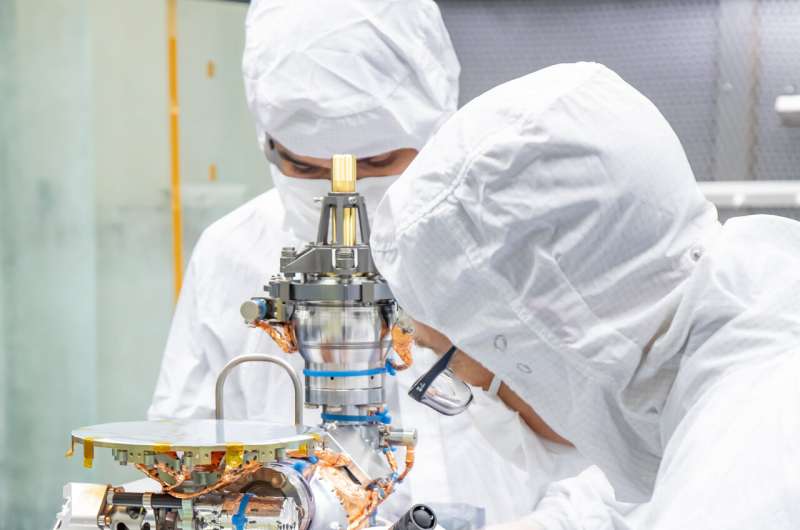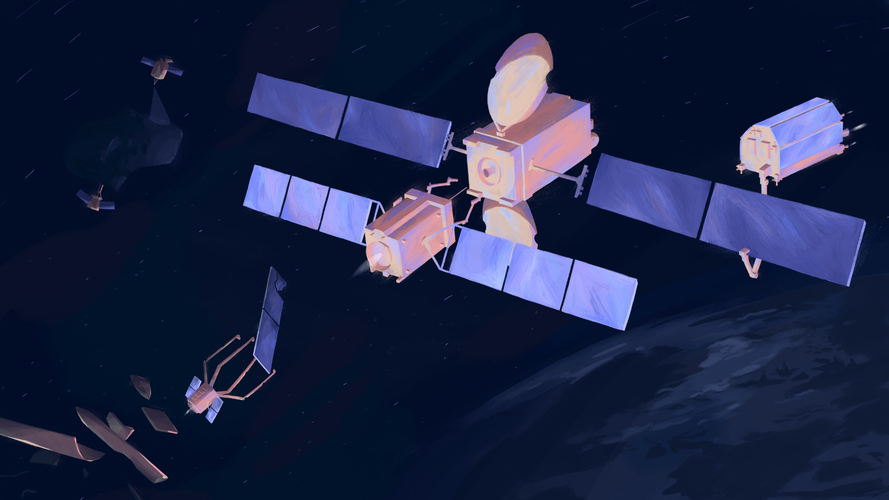SwRI delivers innovative instrument for NASA's Europa Clipper mission
Friday, 06 January 2023 07:08 A groundbreaking new mass spectrometer designed and built by Southwest Research Institute (SwRI) has been delivered for integration onto NASA's Europa Clipper spacecraft. Scheduled to launch in 2024 and arrive in the Jovian system by 2030, Europa Clipper will conduct a detailed science investigation of the moon Europa and study whether it could harbor conditions suitable for life.
The MAss
A groundbreaking new mass spectrometer designed and built by Southwest Research Institute (SwRI) has been delivered for integration onto NASA's Europa Clipper spacecraft. Scheduled to launch in 2024 and arrive in the Jovian system by 2030, Europa Clipper will conduct a detailed science investigation of the moon Europa and study whether it could harbor conditions suitable for life.
The MAss KSAT to support NOAA's Deep Space Solar Observatory
Friday, 06 January 2023 07:08 KBR has selected KSAT to provide all Outside the Continental United States (OCONUS) SWFO Antenna Network (SAN) services. The KBR and KSAT team are developing a blended network including U.S. government ground station sites with KSAT-owned capabilities delivered as a service.
Increased solar activity in recent weeks has provided opportunities for many in the Northern Hemisphere to view the
KBR has selected KSAT to provide all Outside the Continental United States (OCONUS) SWFO Antenna Network (SAN) services. The KBR and KSAT team are developing a blended network including U.S. government ground station sites with KSAT-owned capabilities delivered as a service.
Increased solar activity in recent weeks has provided opportunities for many in the Northern Hemisphere to view the Strengthening electron-triggered light emission
Friday, 06 January 2023 07:08 The way electrons interact with photons of light is a key part of many modern technologies, from lasers to solar panels to LEDs. But the interaction is inherently a weak one because of a major mismatch in scale: A wavelength of visible light is about 1,000 times larger than an electron, so the way the two things affect each other is limited by that disparity.
Now, researchers at MIT and el
The way electrons interact with photons of light is a key part of many modern technologies, from lasers to solar panels to LEDs. But the interaction is inherently a weak one because of a major mismatch in scale: A wavelength of visible light is about 1,000 times larger than an electron, so the way the two things affect each other is limited by that disparity.
Now, researchers at MIT and el Iridium and Qualcomm collaborate to support satellite messaging in smartphones
Friday, 06 January 2023 07:08 Iridium Communications Inc. (Nasdaq: IRDM) has entered into an agreement with Qualcomm Technologies, Inc. to enable satellite messaging and emergency services in smartphones powered by Snapdragon Mobile Platforms. Qualcomm Technologies' new Snapdragon Satellite solution is supported by the fully operational Iridium satellite constellation. Emergency messaging using Snapdragon Satellite is expect
Iridium Communications Inc. (Nasdaq: IRDM) has entered into an agreement with Qualcomm Technologies, Inc. to enable satellite messaging and emergency services in smartphones powered by Snapdragon Mobile Platforms. Qualcomm Technologies' new Snapdragon Satellite solution is supported by the fully operational Iridium satellite constellation. Emergency messaging using Snapdragon Satellite is expect Quectel expands its 5G and GNSS Combo Antennas Portfolio
Friday, 06 January 2023 07:08 Quectel Wireless Solutions, a global IoT solutions provider, has launched three new combo antennas to help IoT solution designers and developers optimize device performance.
Each new combo antenna has been designed to offer maximized choice and performance for IoT deployments so customers can ensure their devices can access the connectivity they need across a variety of wireless technologi
Quectel Wireless Solutions, a global IoT solutions provider, has launched three new combo antennas to help IoT solution designers and developers optimize device performance.
Each new combo antenna has been designed to offer maximized choice and performance for IoT deployments so customers can ensure their devices can access the connectivity they need across a variety of wireless technologi Voyager Space and Airbus announce partnership for Starlab Space Station
Friday, 06 January 2023 07:08 Voyager Space and Airbus Defence and Space are partnering to develop and operate Starlab, a free-flying space station to serve the National Aeronautics and Space Administration (NASA) and a global customer base of space agencies and researchers. Starlab is planned to be launched in 2028 to ensure a continued human presence in Low-Earth Orbit (LEO).
Airbus Defence and Space will provide tec
Voyager Space and Airbus Defence and Space are partnering to develop and operate Starlab, a free-flying space station to serve the National Aeronautics and Space Administration (NASA) and a global customer base of space agencies and researchers. Starlab is planned to be launched in 2028 to ensure a continued human presence in Low-Earth Orbit (LEO).
Airbus Defence and Space will provide tec General Atomics selected to build satellite for AFRL cislunar mission
Thursday, 05 January 2023 20:30
General Atomics Electromagnetic Systems won a contract from Advanced Space to build a satellite the Air Force Research Laboratory plans to launch to deep space in 2025.
The post General Atomics selected to build satellite for AFRL cislunar mission appeared first on SpaceNews.
Iridium and Qualcomm to bring satellite connectivity to smartphones this year
Thursday, 05 January 2023 19:50
Iridium unveiled chip maker Qualcomm Jan. 5 as the partner behind plans to connect smartphones to its satellite constellation this year.
The post Iridium and Qualcomm to bring satellite connectivity to smartphones this year appeared first on SpaceNews.
New mass spectrometer for NASA's Europa Clipper mission
Thursday, 05 January 2023 17:48
Virgin Orbit preparing for first U.K. launch
Thursday, 05 January 2023 12:17
After technical and licensing delays, Virgin Orbit is gearing up for its first launch from the United Kingdom as soon as Jan. 9.
The post Virgin Orbit preparing for first U.K. launch appeared first on SpaceNews.
Impulse Space announces first orbital transfer vehicle mission
Thursday, 05 January 2023 11:35
Impulse Space announced Jan. 4 it will launch its first orbital transfer vehicle late this year on a SpaceX rideshare mission.
The post Impulse Space announces first orbital transfer vehicle mission appeared first on SpaceNews.
NorthStar raises $35 million for debris-tracking satellites
Thursday, 05 January 2023 10:01
Canada’s NorthStar Earth and Space said Jan. 5 it has raised $35 million ahead of plans to deploy its first three satellites this year for tracking objects in orbit.
The post NorthStar raises $35 million for debris-tracking satellites appeared first on SpaceNews.
Last-mile orbital delivery service gets Boost! from ESA
Thursday, 05 January 2023 10:00
Swiss start-up Coactum is to press ahead with development of its in-space transportation service to bring small satellites into their targeted orbital destinations, with support from ESA’s Boost! programme.
Airbus to provide Poland with a very high resolution optical satellite system
Thursday, 05 January 2023 09:23 Airbus Defence and Space has signed a contract with Poland to provide a geospatial intelligence system including the development, manufacture, launch and delivery in orbit of two high-performance optical Earth observation satellites.
The contract also covers the associated ground segment, including Direct Receiving Station in Poland, launch services, training for the Polish team, maintenan
Airbus Defence and Space has signed a contract with Poland to provide a geospatial intelligence system including the development, manufacture, launch and delivery in orbit of two high-performance optical Earth observation satellites.
The contract also covers the associated ground segment, including Direct Receiving Station in Poland, launch services, training for the Polish team, maintenan Kleos KSF1 geospatial intelligence released to customers
Thursday, 05 January 2023 09:23 Kleos Space has confirms it is successfully processing RF data collected by the Vigilance Mission (KSF1) satellites through its signal processing technology platform to create its geospatial intelligence (GEOINT) product, LOCATE, which has been released to initial customers alongside other intelligence collected by the Vigilance Mission.
Kleos CEO Andy Bowyer said, "Our geospatial intellig
Kleos Space has confirms it is successfully processing RF data collected by the Vigilance Mission (KSF1) satellites through its signal processing technology platform to create its geospatial intelligence (GEOINT) product, LOCATE, which has been released to initial customers alongside other intelligence collected by the Vigilance Mission.
Kleos CEO Andy Bowyer said, "Our geospatial intellig 
